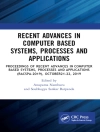In the first approximation, decision making is nothing else but an optimization problem: We want to select the best alternative. This description, however, is not fully accurate: it implicitly assumes that we know the exact consequences of each decision, and that, once we have selected a decision, no constraints prevent us from implementing it. In reality, we usually know the consequences with some uncertainty, and there are also numerous constraints that needs to be taken into account. The presence of uncertainty and constraints makes decision making challenging. To resolve these challenges, we need to go beyond simple optimization, we also need to get a good understanding of how the corresponding systems and objects operate, a good understanding of why we observe what we observe – this will help us better predict what will be the consequences of different decisions. All these problems – in relation to different application areas – are the main focus of this book.
Tabella dei contenuti
Preface.- directory Preface.- 1. Applications to Biology and Medicine.- Hunting Habits of Predatory Birds: Theoretical Explanation of an Empirical Formula.- Why Rectified Power (Re PU) Activation Functions Are Efficient in Deep Learning: A Theoretical Explanation.- Aquatic Ecotoxicology: Theoretical Explanation of Empirical Formulas.- How Hot Is Too Hot.- How Order and Disorder Affect People’s Behavior: An Explanation.- Shape of an Egg: Towards a Natural Simple Universal Formula.- A General Commonsense Explanation of Several Medical Results.- Why Immunodepressive Drugs Often Make People Happier.- Systems Approach Explains Why Low Heart Rate Variability Is Correlated with Depression (and Suicidal Thoughts).- 2. Applications to Economics and Politics.- How to Make Inflation Optimal and Fair.- Why Seneca Effect?.- Why Rarity Score Is a Good Evaluation of a Non-Fungible Token.- Resource Allocation for Multi-Tasking Optimization: Explanation of an Empirical Formula.- Everyone Is Above Average: Is It Possible? Is It Good?.- How Probable is a Revolution? A Natural Re LU-Like Formula that Fits the Historical Data.- Why Should Exactly 1/4 Be Returned to the Original Owner: An Economic Explanation of an Ancient Recommendation.- Why Would Anyone Invest in a High-Risk Low-Profit Enterprise?.- Which Interval-Valued Alternatives Are Possibly Optimal If We Use Hurwicz Criterion.- How to Solve the Apportionment Paradox.- In the Absence of Information, the Only Reasonable Negotiation Scheme Is Offering a Certain Percentage of the Original Request: A Proof.- 3. Applications to Education.- How to Make Quantum Ideas Less Counter-Intuitive: A Simple Analysis of Measurement Uncertainty Can Help.- Physical Meaning Often Leads to Natural Derivations in Elementary Mathematics: On the Examples of Solving Quadratic and Cubic Equations.- Towards Better Ways to Compute the Overall Grade for a Class.- Why Some Theoretically Possible Representations of Natural Numbers Were Historically Used and Some Were Not: An Algorithm-Based Explanation.- 4. Applications to Engineering.- Dielectric Barrier Discharge (DBD) Thrusters — Aerospace Engines of the Future: Invariance-Based Analysis.- Need for Optimal Distributed Measurement of Cumulative Quantities Explains the Ubiquity of Absolute and Relative Error Components.- Over-Measurement Paradox: Suspension of Thermonuclear Research Center and Need to Update Standards.- How to Get the Most Accurate Measurement-Based Estimates.- How to Estimate The Present Serviceability Rating of a Road Segment: Explanation of an Empirical Formula.- 5. Applications to Linguistics.- Word Representation: Theoretical Explanation of an Empirical Fact.- Why Menzerath’s Law?.- 6. Applications to Machine Learning.- One More Physics-Based Explanation for Rectified Linear Neurons.- Why Deep Neural Networks: Yet Another Explanation.- 7. Applications to Mathematics.- Really Good Theorems Are Those That End Their Life as Definitions: Why.- 8. Applications to Physics.- How to Describe Hypothetic Truly Rare Events (with Probability 0).- Spiral Arms Around a Star: Geometric Explanation.- Why Physical Power Laws Usually Have Rational Exponents.- Freedom of Will, Non-Uniqueness of Cauchy Problem, Fractal Processes, Renormalization, Phase Transitions, and Stealth Aircraft.- How Can the Opposite to a True Theory Be Also True? A Similar Talmudic Discussion Helps Make This Famous Bohr’s Statement Logically Consistent.- How to Detect (and Analyze) Independent Subsystems of a Black-Box (or Grey-Box) System.- 9. Applications to Psychology and Decision Making.- Why Decision Paralysis.- Why Time Seems to Pass Slowly for Unpleasant Experiences and Quickly for Pleasant Experiences: An Explanation Based on Decision Theory.- How to Deal with Conflict of Interest Situations When Selecting the Best Submission.- Why Aspirational Goals: Geometric Explanation.- Why Hate: Analysis Based on Decision Theory.- Why Self-Esteem Helps to Solve Problems: An Algorithmic Explanation.- Why Five Stages of Solar Activity, Why Five Stages of Grief, Why Seven Plus Minus Two: A General Geometric Explanation.- 10. Applications to Software Engineering.- Anomaly Detection in Crowdsourcing: Why Midpoints in Interval-Valued Approach.- Unexpected Economic Consequence of Cloud Computing: A Boost to Algorithmic Creativity.- Unreachable Statements Are Inevitable In Software Testing: Theoretical Explanation.- 11. General Computational Techniques.- Why Constraint Interval Arithmetic Techniques Work Well: A Theorem Explains Empirical Success’.- ‘How to Describe Relative Approximation Error? A New Justification for Gustafson’s Logarithmic Expression’.- Search Under Uncertainty Should be Randomized: A Lesson From the 2021 Nobel Prize in Medicine’.- Why Convex Combination Is an Effective Crossover Operation in Continuous Optimization: A Theoretical Explanation’.- ‘Why Optimization Is Faster than Solving Systems of Equations: A Qualitative Explanation’.- Estimating Skewness and Higher Central Moments of an Interval-Valued.- Fuzzy Set’.- How to Detect the Fundamental Frequency: Approach Motivated by Soft.- Computing and Computational Complexity’.- What If There Are Too Many Outliers?’.- What Is a Natural Probability Distribution on the Class of All Continuous Functions: Maximum Entropy Approach Leads to Wiener Measure’.- An Argument in Favor of Piecewise-Constant Membership Functions’.- ‘Data Processing under Fuzzy Uncertainty: Towards More Accurate Algorithms’.- ‘Epistemic vs. Aleatory: Case of Interval Uncertainty’.- ‘Standard Interval Computation Algorithm Is Not Inclusion-Monotonic: Examples’.- ‘Monotonic Bit-Invariant Permutation-Invariant Metrics on the Set of All Infinite Binary Sequences’.- Computing the Range of a Function-of-Few-Linear-Combinations Under Linear Constraints: A Feasible Algorithm’.- ‘How to Select a Representative Sample for a Family of Functions?.












